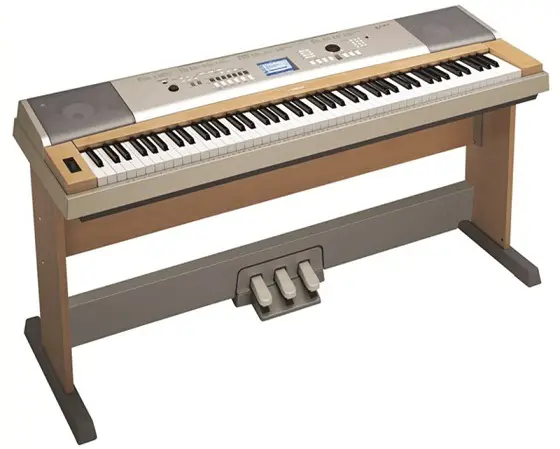
Yamaha LP-7A 3-Pedal system includes three-piano pedals that allow you to get authentic sustain/damping, sostenuto, and soft pedal sounds, commonly found on grand pianos, with half-damper effect on your digital piano (grand piano keyboards).
Features
- It comes with a lead which plugs into the sustain port on the Yamaha Keyboard
- Damper, soft and sostenuto pedals
- Half damper effect for expressive control over sustained sound
- Left pedal can be assigned to control some of the internal voices
- Allows the piano performer to add more refined musical expressions
- Perfect for piano players and music students
Review
The Yamaha LP-7A pedal unit has three foot pedals that produce a range of expressive effects similar to those produced by the pedals on an acoustic piano. The expressive effects are controlled by the damper, soft, and sostenuto pedals including half damper effect which produces a more realistic control over the sustained sound. Perfect for piano players and music students.
These pedals are great for use with grand keyboards from the YPG and DGX series.
Here’show the three pedals work:
Damper Pedal (Right)
The damper pedal functions in the same was as a damper pedal on an acoustic piano. When the damper pedal is pressed, notes sustain longer. Releasing the pedal immediately stops (damps) any sustained notes. A half-pedal effect lets you use the damper pedal to create partial sustain effects depending on how far down you press the pedal.
Sostenuto Pedal (Center)
If you play a note or chord on the keyboard and press the sostenuto pedal while the notes are held, those notes will sustain as long as you hold the pedal (as if the damper pedal had been pressed) but all subsequently played notes will not be sustained. This makes it possible to sustain a chord, for example, while other notes are played staccato.
Soft Pedal (Left)
The soft pedal reduces the volume and slightly changes the timbre of notes played while the pedal is pressed. The soft pedal will not affect notes that are already playing when it is pressed.
Pros & Cons
- Pros: Unit attaches to a crossbeam that mounts directly on the Yamaha keyboard stand, so no sliding of the pedals. You can adjust the height of the pedals. Looks good on a digital piano. Half Damper effect that lets piano players add more style and musical expressiveness to their playing.
- Cons: Quality is reasonable as the pedals are made of plastic
Video Review
Yamaha LP-7A: Buying Links & Pricing
Get authentic pedaling experience and sounds on your digital piano using the Yamaha LP-7A 3-Pedal System. The best thing is that it stays attached to a mount on the stand, and enhances the look of your piano keyboard.
- [easyazon_link identifier=”B0029RVWUO” locale=”US” tag=”keytarhq04-20″]Buy on Amazon[/easyazon_link] | Buy on zZounds
Get a realistic pedal action for your Yamaha DGX piano keyboard with the LP-7A. If you want something cheaper, yet robust, checkout the M-Audio SP-2 Sustain Pedal. Its an excellent single piano pedal, very sturdy (but does move around a bit). You can checkout more piano pedals here.
KeytarHQ editorial team includes musicians who write and review products for pianists, keyboardists, guitarists & other musicians. KeytarHQ is the best online resource for information on keyboards, pianos, synths, keytars, guitars and music gear for musicians of all abilities, ages and interests.



Its functional but the experienced players are not going to like its cheap feel (its plasticky). They also tend to creak a bit when you press them while playing. Not noticeable when playing through headphones, but can be irritating when heard through the standard keyboard speakers (only when playing at low volumes).
Anybody has any information about the pins of the connector, or about the variable resistors used? Which Pin is connected to which resistor or which pedal of the LP7A. I would like to use a Korg PU-2 pedal unit with my DGX keyboard, but will need to build an adaptor to connect the PU-2 pedal to my Yamaha DGX keyboard.
You may check the manual. In my case the plastic pivot point had broken. But I didn’t repair it, just bought the M-Audio SUS-2, which works great (slides a bit though). The LP7A was very cool till it lasted, but gave way soon..have heard that they typically break within 2 years.
I had bought the Yamaha LP-7A for my DGX-640 but it wore out too soon. An internal part of the main structure broke and I could not use it further. I loved the pedal though, but for most players a single-pedal unit should suffice, although it skids around sometimes.
The Yamaha LP-7A Three Pedal System really compliments your keyboard. You will see a marked improvement in the sound. We bought these pedal units for each of the DGX-650 keyboards at our school and they work great. Easy to assemble or take off if needed.